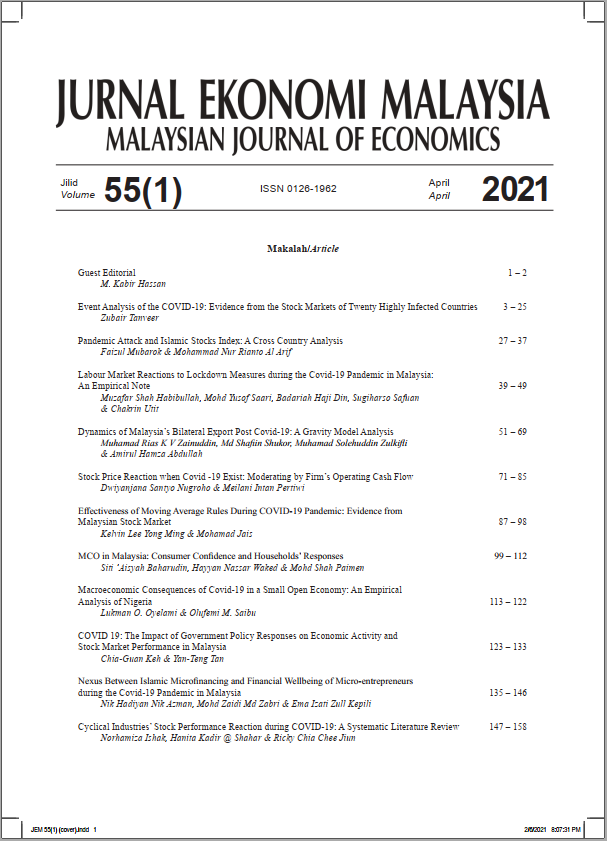Jurnal Ekonomi Malaysia
55 (1) 2021 51 – 69
Fakulti Perniagaan Ekonomi dan Pembangunan Sosial
Universiti Malaysia Terengganu
21030 Kuala Nerus, Terengganu
MALAYSIA
Fakulti Ekonomi dan Pengurusan
Universiti Kebangsaan Malaysia
43600 Bangi, Selangor
MALAYSIA
Fakulti Pengurusan dan Perniagaan,
Universiti Teknologi Mara Cawangan Terengganu,
23000 Dungun, Terengganu
MALAYSIA
Institut Masa Depan Malaysia
192, Jalan Ara, Bukit Bandaraya
59100 Kuala Lumpur
MALAYSIA
Abstract
The recent pandemic outbreak has distorted international trade flows as the global economic activity reaches a nearstandstill due to stricter movement control imposed by most countries worldwide. Despite gaining the researcher’s attention, the impact of Covid-19 on trade performances are still relatively understudied. Hence, this study aims to analyse the impact of the Covid-19 pandemic outbreak on the bilateral sectoral export for Malaysia. This study employs Poisson Pseudo Maximum Likelihood (PPML) regressions to analyse the sectoral impact in gravity models. The findings provide new perspectives on the varying impacts of the current pandemic outbreak on sectoral trade performances. The dummy variables that represent the existence of Covid-19 have significantly reduced bilateral
exports for 11 sectors while increased the exports for seven sectors. Meanwhile, the severity of the Covid-19 outbreak (measured by the number of new cases and death cases) in Malaysia has negative impacts on 14 sectors. The reason for this is that when the current pandemic outbreak in Malaysia is more severe, the government has to enforce stricter movement controls that affect productions and reduce exports. On the other hand, the severity of the Covid-19 outbreak in trading partners has positive impacts on the export for 13 sectors in Malaysia. This is because the more severe pandemic outbreak in trading nations causes lower production capacities and thus higher dependence on imported goods. Differences between the impact of Covid-19 existence and severity by sectors should serve as a red flag for Malaysia’s policymakers to take immediate actions to minimise the impact of the ongoing pandemic outbreak and maximise gains from sectors that have higher demand post Covid-19. The net negative impact on the export performance further reiterates the need for government intervention policies to ensure domestic firms can withstand the current tide, which then minimises the social and economic impacts and helps the economy to recover.
Keywords
JEL Codes
Similar Articles
- Demand for Malaysian Higher Education among ASEAN Countries: An Income Classification based Analysis
- Determinants of International Tourism in Malaysia: Evidence from Gravity Model
- Export-led Growth Hypothesis in Malaysia: New Evidence Using Disaggregated Data of Exports
Bibliography
@article{zainuddin2021dynamics,
title={Dynamics of Malaysia’s Bilateral Export Post Covid-19: A Gravity Model Analysis},
author={Zainuddin, Muhamad Rias K V and Shukor, Md Shafiin and Zulkifli, Muhamad Solehuddin and Abdullah, Amirul Hamza},
journal={Jurnal Ekonomi Malaysia},
volume={55},
number={1},
pages={51—69},
}
Receive updates when new articles are published.


